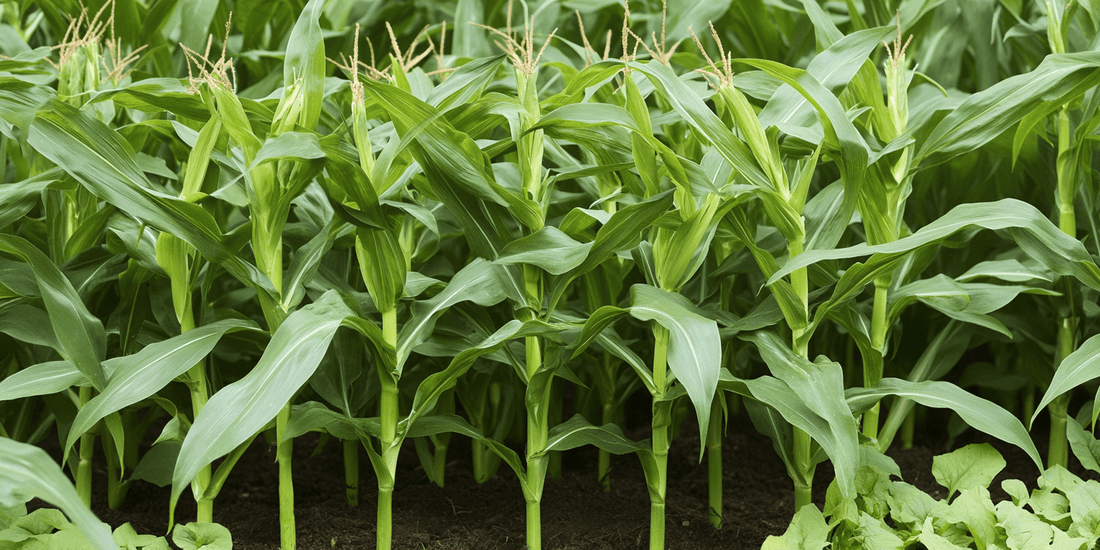Best Companion Plants for Corn
Companion plants support corn by improving soil health, deterring pests, or providing mutual benefits like shade or structural support. Choosing the right companions ensures healthier plants and higher yields.
Legumes
Legumes like beans and peas are excellent companions for corn because they fix nitrogen in the soil, enriching it for the heavy-feeding corn plants.
- Pole Beans: Use corn stalks as natural trellises while supplying nitrogen to the soil.
- Soybeans: Provide similar nitrogen-fixing benefits while also covering the soil to suppress weeds.
Squash and Pumpkins
Vining squash plants provide ground cover, which helps retain soil moisture and reduce weed competition. Their prickly vines also deter pests like raccoons from raiding corn.
- Zucchini: A compact squash variety that fits well in smaller gardens.
- Butternut Squash: Offers excellent ground coverage and long-term storage benefits.
Sunflowers
Sunflowers act as windbreaks for delicate corn plants and attract pollinators, which improves overall garden health.
- ‘Mammoth’ Sunflowers: Tall and sturdy, perfect for shielding corn from strong winds.
- Dwarf Sunflowers: Compact varieties that provide the same benefits without overshadowing smaller plants.
Herbs
Herbs can repel pests and attract beneficial insects to the garden.
- Dill: Attracts ladybugs and parasitic wasps that prey on aphids and caterpillars.
- Basil: Repels flies and mosquitoes while improving pollination rates.
The Three Sisters Method
The Three Sisters planting technique is one of the most well-known companion planting strategies. Developed by Indigenous peoples, this method involves intercropping corn, beans, and squash for mutual benefits.
How the Three Sisters Work
- Corn: Provides vertical support for climbing beans.
- Beans: Fix nitrogen in the soil, feeding the corn and squash.
- Squash: Spreads across the ground, acting as a living mulch to retain moisture and suppress weeds.
Planting the Three Sisters
Step 1: Prepare the Soil
- Ensure the soil is rich in organic matter and well-drained. Corn thrives in nitrogen-rich environments, which is why beans are essential to this method.
Step 2: Plant the Corn
- Create small mounds spaced 4 feet apart and plant corn seeds in the center of each mound.
Step 3: Add the Beans
- Once the corn is about 6 inches tall, plant pole beans around each mound.
Step 4: Plant the Squash
- Finally, plant squash or pumpkin seeds around the perimeter of each mound.
Benefits of the Three Sisters Method
- Improved Soil Health: Beans replenish nitrogen, reducing the need for synthetic fertilizers.
- Pest Control: Squash deters pests with its spiny leaves.
- Efficient Use of Space: The vertical and horizontal spread of the plants maximizes garden productivity.
Pest-Repellent Plants
Using pest-repellent plants as companions for corn is a natural and sustainable way to manage garden pests without relying on chemical pesticides.
Marigolds
Marigolds are famous for their ability to repel nematodes and other soil-borne pests. Planting them near corn can protect the roots from damage.
- French Marigolds: Particularly effective against nematodes.
- African Marigolds: Larger varieties that also deter aphids and whiteflies.
Nasturtiums
These vibrant flowers repel aphids, squash bugs, and whiteflies. They also serve as trap crops, drawing pests away from corn.
Garlic and Onions
Strongly scented alliums confuse and repel pests like aphids and beetles. Their shallow root systems won’t compete with corn for nutrients.
- Garlic ‘Music’: Known for its robust growth and pest-repellent properties.
- ‘Yellow Sweet Spanish’ Onions: A versatile allium that thrives in a range of conditions.
Aromatic Herbs
Certain herbs can deter common corn pests:
- Cilantro: Repels spider mites and attracts beneficial insects.
- Mint: Strong scent deters ants and aphids but should be contained to prevent spreading.
Intercropping Corn with Beneficial Plants
Intercropping corn with diverse companion plants creates a resilient and productive garden system.
Benefits of Intercropping Corn
- Pest Control: Diversified plantings reduce the spread of pests that target monocultures.
- Weed Suppression: Ground-hugging plants like squash and beans cover bare soil.
- Soil Health: Different plants use and replenish various nutrients, maintaining soil fertility.
Examples of Successful Intercropping
- Corn and Clover: Clover fixes nitrogen in the soil and acts as a living mulch.
- Corn and Radishes: Radishes grow quickly, providing an early harvest before corn reaches full height.
Organic Pest Control Strategies
In addition to pest-repellent plants, organic pest control methods can further protect corn from damage.
Beneficial Insects
- Introduce ladybugs and lacewings to prey on aphids and caterpillars.
- Parasitic wasps can reduce populations of corn earworms and borers.
Natural Sprays
- Neem oil or insecticidal soaps can deter pests without harming beneficial insects.
Physical Barriers
- Use row covers to protect young corn plants from pests like armyworms and beetles.
Plants to Avoid Growing Near Corn
While many plants make excellent companions for corn, some should be avoided due to competition or pest attraction.
Tomatoes
Tomatoes and corn are both heavy feeders, which can lead to nutrient competition. They are also susceptible to similar pests, like corn earworms.
Fennel
Fennel can inhibit the growth of nearby plants, including corn, due to its allelopathic properties.
In Summary
Companion planting with corn is a time-tested method to enhance plant health, manage pests, and maximize garden productivity. Whether you use the Three Sisters method, integrate pest-repellent plants like marigolds and nasturtiums, or experiment with intercropping, the benefits of thoughtful planning are undeniable. By selecting the best plants for corn, you create a sustainable and thriving garden ecosystem that supports your organic growing goals.
In Summary
Growing corn in small spaces is achievable with the right strategies, from container corn gardening to choosing dwarf corn varieties. With techniques like space-saving corn tips and intercropping, you can enjoy a productive corn harvest in urban environments or compact gardens. Embrace sustainable practices, select compact corn for urban gardens, and explore varieties like ‘Trinity’ Sweet Corn or ‘Blue Jade’ for success.
For more information, see our article on Corn Growing Guide or start with the step-by-step Beginner’s Guide to Growing Corn.






